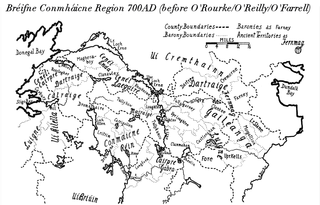Aedh mac Ruaidrí Ua Conchobair was King of Connacht from 1228 to 1233. He was one of the sons of the last fully recognized High King of Ireland Ruaidrí Ua Conchobair, and claimed the kingship of Connacht after deposing his brother Toirdhealbhach Ó Conchobhair, after the death of their rival, cousin and former king Aedh Ua Conchobair. In 1233 he was killed in battle by the supporters of his cousin and successor Felim O'Connor. He was the last descendant of Ruaidrí to hold the kingship.
Áed mac Felidlimid Ó Conchobair, known as Áed na nGall, was king of Connacht alongside his father Felim from 1258 reigning solely from 1265 until his own death in 1274. He is credited with turning the tide on Norman expansion in Connacht at the Battle of Áth an Chip. Aed took a different approach than his father to dealing with English crown authority in Ireland, placing his faith in alliances with the Gaelic speaking world and becoming the chief supporter of Brian Ua Neill's bid to revive the high kingship of Ireland. His byname na nGall comes from his marriage in 1259 to a daughter of Dubhghall mac Ruaidri King of the Hebrides which brought him 160 gallowglass commanded by Dubhghall's younger brother Ailéan as a dowry.
Toirdhealbhach ua Briain, anglicised Turlough O'Brien, was King of Munster and effectively High King of Ireland. A grandson of Brian Bóruma, Toirdelbach was the son of Tadc mac Briain who was killed in 1023 by his half-brother Donnchad mac Briain.

Costello is one of the ancient baronies of Ireland. Unusually for an Irish barony, it straddles two counties: County Mayo and County Roscommon. It comprises the modern day districts of Kilkelly, Kilmovee, Killeagh, Kilcolman, and Castlemore.

Mac Siúrtáin, aka Mac Jordan and Jordan, is the name of a Connacht family of Norman-Irish origins.
Mac Cú Ceanain was King of Uí Díarmata.
Mughron Ua Níoc was Abbot of Tuam.
Fearghal Ó Gadhra, sometimes referred to as Farrell O'Gara, was lord of Coolavin, and patron of the Annals of the Four Masters.
Toichleach Ua Gadhra, King of Gailenga, in medieval Ireland, died in 964.

Gailenga was the name of two related peoples and kingdoms found in medieval Ireland in Brega and Connacht.
The Kings of Luighne Connacht were rulers of the people and kingdom of Luighne Connacht, located in what is now County Mayo and County Sligo, Ireland.
Donn Sléibhe Ó Gadhra, King of Sliabh Lugha, died 1217.
Ruaidrí Ó Gadhra was an Irish king of Sliabh Lugha and Chief of the Name.
Ruaidri Ó Gadhra was an Irish Lord.
The Ó Gadhra Chiefs of the Name were the heads of the Clan O'Gara, who were originally located in Sliabh Lugha, the southern part of the territory ruled by the Kings of Luighne Connacht. In the 13th century they were expelled from the area and moved to Cul Ui Fionn, later known as the barony of Coolavin, County Sligo.
Eaghra Poprigh mac Saorghus was eponym and ancestor of the clan Ó hEaghra, King of Luighne Connacht.
The Corca Fhir Trí were an Irish people located in the kingdom of Gailenga, Luighne Connacht and Corann in Gaelic Ireland.
Luighne Connacht was a territory located in north-central Connacht, on the borders of what is now County Mayo and County Sligo, Ireland. The Tuatha of Luighne was co-extensive with the modern day boundary of the Roman Catholic Diocese of Achonry
The Fortúatha were "kingdoms not ruled directly by members of the dominant dynasty of a province". They have also been described as "in effect, people belonging to a different stock from that of the rulers of the territory", yet sometimes enjoying a position of favour with the ruling people.
Ó Gadhra or O'Gara is an Irish surname which originated in the kingdom of Luighne Connacht. Variants include Garry, Geary, Gerry, and Guiry.


